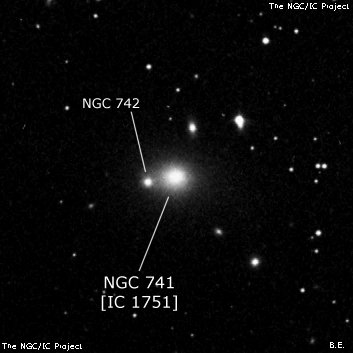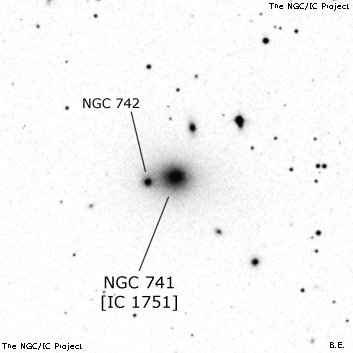NGC/IC Project Restoration Effort
(This is a very very beta version)
NGC741


Basic Information
Location and Magnitude
Right Ascension: 1:56:20.9
Declination: +5:37:43
Constellation: PSC
Visual Magnitude: 11.1
Historic Information
Discoverer: Herschel W.
Year of discovery: 1784
Discovery aperture: 18.7
Observational
Summary description: pF, S, R, p of 2, pos 102┬░
Sub-type: E0
Corwin's Notes
=====
NGC 741 = IC 1751. This, along with NGC 742, was discovered by William
Herschel, reobserved by John Herschel, and by Lord Rosse. N741 itself is the
brightest in a group of galaxies, and the positions in NGC from the Herschels
are good. Furthermore, their descriptions make it clear that all saw the same
two galaxies. They did not pick up any of the other objects in the area.
This leads to the puzzle of why the brighter of the two was also included in
IC. True, it reappeared in Swift's 11th list of "new" nebulae (with one of
his typically inaccurate positions), and was reobserved by Herbert Howe at
Chamberlin Observatory in Denver. Howe provided a very good micrometric
position for it which was adopted by Dreyer for the IC. I suspect that as
Dreyer had come to trust Howe's positions and identifications (most of Howe's
observations are of known objects), he (Dreyer) didn't bother to check the NGC
to see if the galaxy had been seen previously.
More recently, the IC number has been attached in CGCG (and in other
subsequent lists) to the galaxy (CGCG 413-006) just over an arcminute
northwest of N741. This object is indeed brighter than many that Swift found,
but his description of a 9th magnitude star "north-preceding" rather than
simply "preceding" pretty well establishes the identity. It is further
pinned down by Howe's measurement of the distance and direction to the star
(actually a double, or perhaps a single star superposed on a galaxy) which
points exactly to N741 as the object that he measured.
Steve's Notes
=====
NGC 741
24" (12/21/16): at 375x; bright, moderately large, round, sharply concentrated with a small very bright core that increases to the center. The halo increases with averted to over 1'. A mag 11 star is 2.4' NW. NGC 741 is the brightest in a group (WBL 061) with NGC 742 0.8' E of center, at the edge of the halo. NGC 741 has a╩extended X-ray halo╩reaching a distance of 19' from its center. Furthermore, twin radio jets emerge from the nucleus of NGC 742 and spread into a larger lobe that encircles NGC 741. A total of 8 members of the group were logged within 15' of NGC 741.
CGCG 413-006 (often misidentified as IC 1751) is 1.5' NW. It appeared faint or fairly faint, very small, slightly elongated N-S, 0.3'x0.2', sharp stellar nucleus. The mag 11 star lies 1.4' W.
CGCG 413-002, 3.3' SW of NGC 741, appeared faint to fairly faint, very small, round, 12" diameter.
CGCG 413-001, 9.5' NW of NGC 741, is very faint, very small, elongated ~2:1 ~E-W, 18"x9". Not noticed initially but once picked up could just hold continuously with careful averted vision.
CGCG 413-010, 11' NNE of NGC 741, is faint, very small, irregularly round, ~15"x12".
UGC 1425, 12' NE of NGC 741, is fairly faint to moderately bright, small, roundish, 18" diameter, high surface brightness (core only), occasional sharp stellar nucleus. Increases a bit in size with averted.
UGC 1435, 15' E of NGC 741, is faint, fairly small, oval 3:2 SW-NE, 30"x20", very low surface brightness patch, no core or zones. Collinear with two 14th magnitude stars 2' and 3' E.
17.5" (11/6/93): moderately bright, round, prominent core, faint stellar nucleus at moments, larger halo with averted. A mag 11 star is 2.4' NW. In a common halo with NGC 742 attached at the east end at 0.8' separation in pa 100í. Brightest in a group and forms a close triple with MCG +01-06-006 1.5' NNW. CGCG 413-006 (generally misidentified as IC 1751) appeared very faint, very small, slightly elongated N-S. A mag 10.5 star lies 1.3' WNW.
8" (1/1/84): faint, round, diffuse edges, small faint core. A mag 12 star is close NW.



